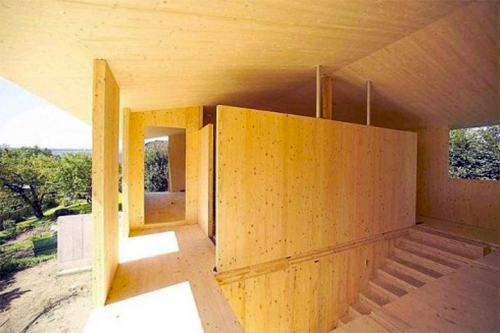
A new Think Wood survey (pdf) gives us a peek into what kinds of wood-related building projects we’ll see a lot more of this year. The industry group surveyed 775 U.S. architects, contractors, developers and industry experts to build a list of the top trends in timber construction, and how much they’ll likely continue to be impacted by the COVID-19 pandemic.
While 38% of respondents expect to see some delays this year, 28% expect no impact at all, and another 28% say they think it’ll all depend on factors like vaccination and reopening schedules in various states. Interestingly, many said their projects have been altered to prioritize good ventilation and lots of space for occupants to remain apart from each other, a trend likely to continue at least a few years into the future.
The report offers five major predictions about the future: more focus on climate change, greater use of mass timber, widespread adoption of prefab and modular construction techniques, higher interest in hybrid construction and higher demand for affordable housing.
Trend 1: Focus on Climate Change
Industry experts say they expect low-to-zero-carbon and green building to be the biggest trend in 2021, driven in large part by industry, government and individual companies’ energy and carbon reduction targets. The market for non-residential green buildings reached about $80 billion in 2020 despite the pandemic, and is expected to reach $103 billion by 2023. Wood products are considered the number one best way to meet these goals, since they require less energy to manufacture and store carbon throughout the useful life of the building or project.
Trend 2: More Mass Timber
Breakthroughs in mass timber technology have made super-tall wooden buildings possible, and this material will continue to rise in adoption and popularity this year. Many mass timber projects are underway in the U.S. right now, and 18% of survey respondents expected to work on at least one.
“Mass timber isn’t simply a green building fad, it’s a resurgence of one of the oldest building materials used by man. The desire to use wood in commercial buildings will increase not only because it’s the more sustainable choice, but because building occupants and tenants will prefer it.” — Andrew Tsay Jacobs, Director of Building Technology Lab, AIA, EIT | Perkins&Will
Trend 3: A Boost in Prefab & Modular
Prefabrication and modular construction cut costs, reduce waste, are much faster to build and rate higher for quality and safety performance than conventional construction. Survey respondents believe that as the building industry adopts tech like 3D modeling tools and CNC machines, these methods will become a lot more common. Wood, of course, remains a popular material for prefab and modular building systems.
“I am now focusing exclusively on prefabricated hybrid residential design and construction solutions that prioritize energy efficiency, low carbon footprints and occupant health and well-being.” — Timber Trends Survey Respondent
Trend 4: Hybrid Construction
We’ll see a lot more wood (especially in the form of mass timber) being integrated into projects that once would have relied primarily on materials like steel and concrete. This “hybrid construction” type of building incorporates several types of structural materials to enhance sustainability and help with budget control.
Trend 5: An Abundance of Affordable Housing
Even before the pandemic, 30.2 percent of American households spent more than 30 percent of their incomes on housing. We need more affordable housing just about everywhere, and survey respondents believe many affordable multi-family developments are coming this year. Timber plays an important role in affordable housing by improving access to living spaces that are economical, comfortable and sustainable, Timber Trends notes, and adding stories to existing buildings is more feasible with timber because of its lighter weight.









